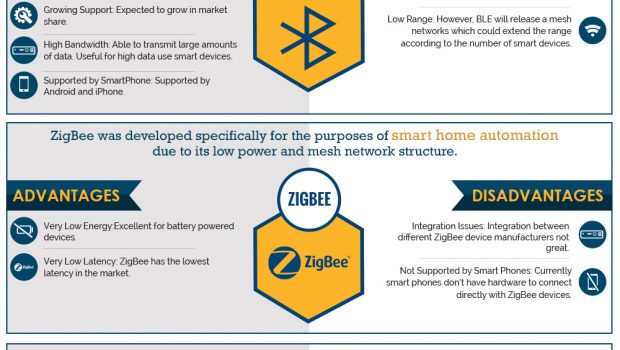Smart Home Protocols Infographic
Home Automation Protocols or Network Protocols will be the most important technical function as we gradually transition into worldwide smart homes. Network Protocols allow smart devices to communicate with each other over vast distances. It is a possibility that smart homes could use the incumbent protocol WiFi. However WiFi presents problems due to interference (already your laptops and smartphones are connecting to this network) and its intense use of power which would leave a lot of battery powered devices drained within a day. For this reason, a lot of these new protocols in the image below were developed, creating a highly fragmented market where different devices are unable to talk with each other.
Another issue is that as smart devices require more power as they increase functions and performance (such as doorbell cameras which need to transfer video data instantly when someone pushes the doorbell button), the home will need to move towards these more powerful network protocols.
Our team at smarthomeSAGE predict that the Bluetooth Low Energy (BLE) protocol will be the winning standard ultimately for the following reasons:
- Widespread Adoption: Already the majority of smartphones have regular Bluetooth connectivity. This will reduce the number of integrations and changes required my cell phone manufacturers who already have limited space within the phone to add additional protocol hardware.
- Mesh Network Adoption: BLE is in the process of moving onto a mesh network style (instead of the star network or direct to hub connection). This will effectively increase the range of the network as each connected device will, in turn, become a range booster.
- Low Energy: Although this protocol is not the lowest energy, it is far lower than WiFI and regular Bluetooth.
An issue which could impact BLE’s utilizes the same frequency to transmit data as WiFi. As more and more devices (the most popular being smart door locks and smart thermostats) are connecting to the same bandwidth, we will see a decrease in performance, which will be more pronounced in big cities due to the larger amount of devices in a concentrated area.
Which protocol do you think will win the smart home race?
About this post:
This is a guest post by Joseph Mack from smarthomeSAGE, a blog that analyzes the impact that smart home technology has on home life. You can follow him on Twitter or Facebook.
















